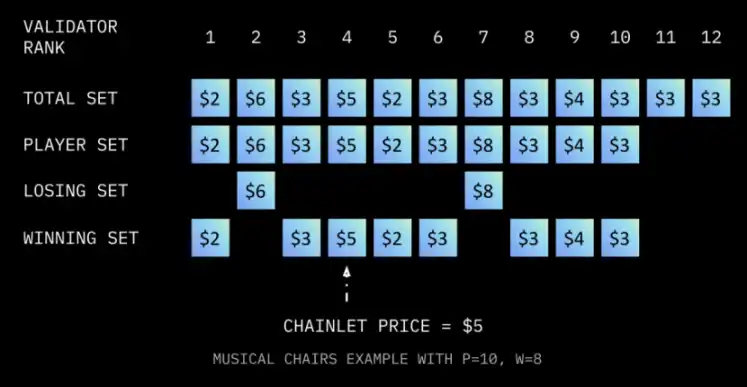In the world of Web3, innovation and flexibility are key factors driving technological progress. The emergence of the SAGA protocol has brought unprecedented freedom and possibilities to developers and users. This article will deeply analyze the uniqueness of the SAGA protocol and its business model, and explore its potential and prospects in the Web3 ecosystem.
What is SAGA?
SAGA is a protocol that rebuilds the Web3 experience, aiming to provide developers and end users with greater flexibility and customizability. Unlike traditional blockchain networks, SAGA is not just a technical tool, but also a customized L1 network that empowers developers.
Musical Chairs Pricing Mechanism

SAGA adopts a unique "Musical Chairs Pricing" mechanism:
Initial state: Assume that there are 12 validators, and SAGA hopes to select 8 of them for delegated verification.
Staking rate ranking: According to the staking rate ranking, the top 10 validators are selected to enter the bidding stage, and the 11th and 12th validators will be eliminated.
Quote sorting: 10 validators make quotes, and the quotes are sorted from low to high. 8 of them are selected as delegated validators, and the price is determined by the highest price among the 8 validators.
Although this mechanism is complex, its goal is to provide the cheapest possible block space through involution. In order to obtain rewards, validators must ensure that they are in the top 8, which is similar to the super node election mechanism of EOS. In the end, the pricing will be close to "cost + a small profit", and will be in a very low range in the long run, thereby continuously eliminating high-cost validators.
Price comparison: Ethereum L2 has reduced its fees after the Cancun upgrade, but it is still not cheap enough compared to Solana. Large-scale applications cannot afford the transaction fee of 0.1U/transaction, so "extremely low and stable fees" are very important for commercial applications.
SAGA's charging model: SAGA's charging model is different from other public chains. Users do not need to pay network fees directly, and applications can decide the charging method by themselves. This model is more in line with Web2's business practices and provides more flexibility. For example, applications can adopt subscription, buyout, advertising charges or even be completely free.
Incentivized Testnet Saga Pegasus: SAGA's incentive testnet Saga Pegasus has attracted hundreds of protocols, and as of April 1, 2024, the program includes 350 projects. 80% of these projects are games, 10% are NFT and entertainment, and 10% are DeFi. This also reflects the applicability of SAGA's economic model - it is more suitable for scenarios with light assets, high user numbers and high user frequency.
Token Distribution
According to the published information, SAGA's initial circulation is only 4.5% of Launchpool and 1.5% of airdrops. The ecosystem and foundation shares can be basically ignored:
75% of chips: distributed through Launchpool, the selling pressure is very limited.
15.5% of airdrops: Only 1.5% has been issued so far, and there may be multiple rounds of airdrops in the future.
Considering that there are hundreds of projects on the incentive testnet (which may issue coins), SAGA is still worth participating in the future, especially staking.
Conclusion: The SAGA protocol brings new possibilities to the Web3 ecosystem through its unique economic model and flexible charging model. Both developers and end users can benefit from it. With the continuous development of the incentive test network and the participation of more projects, SAGA will play an important role in the future Web3 world.